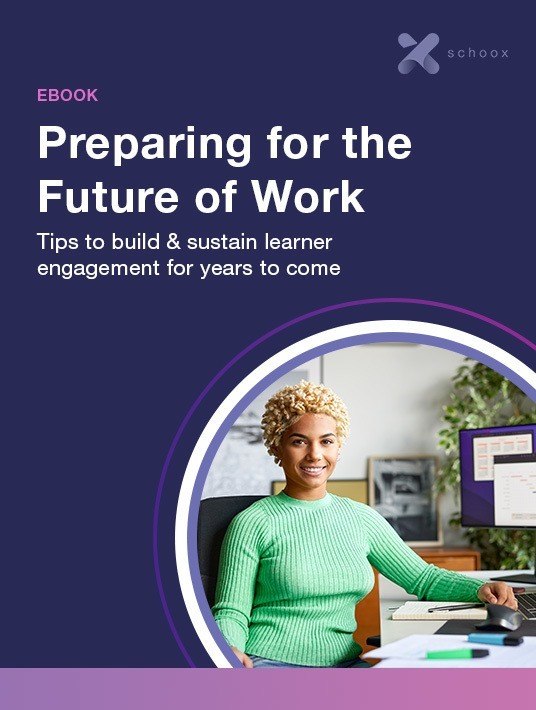The Modern Learner
Training programs that are static and event-based come across as large, boring, and intrusive to people’s daily work, and they definitely don’t take the characteristics of the modern learner into account. Today’s learners:
- Want answers now
- Want learning to be concise
- Want an engaging experience
- Don’t need tons of bells and whistles
- Want to choose their own path
- Will make time to learn despite being busy
- Will continue to adapt and change

What Should You Add To Your L&D Programs To Keep Learning Sticky?
Organizations need to double down on driving the adoption of learning programs, as well as reinforcing and supporting the concepts and skills the learning is trying to build. There are several key elements and characteristics L&D teams can bring into their learning programs to make them more effective.
The Learning Should:
- Be engaging
- Provide opportunities to try and fail
- Reinforce key concepts
- Give learners a sense of accomplishment or mastery
- Include collaboration with peers
- Offer some reward or recognition
Get In The Game
In many organizations, “game” is still a four-letter word that signals the opposite of productivity and performance. The reality is that games offer unique opportunities for organizations to engage and motivate their learners. There are two concepts at play: games and gamification.
Games Vs. Gamification
First, gaming is using actual games to engage employees in an activity. This is typically a point-and-click interface where players guide avatars or characters through a series of questions or challenges. This is where the reservations tend to come from when discussing gaming with business leaders.
Gaming’s next-door neighbor — gamification — also gets painted with the same brush due to a lack of understanding of the difference between the two. Gamification is different. It’s not about playing a game but rather about taking gaming mechanics (achievements, rewards, leveling) and applying them to learning activities.
Gamification In The Real World
Ironically, a great model for gamification can be found in online multiplayer console games such as Call of Duty, Halo, or others. There is the actual game — the shooting, the strategizing, the puzzles, etc. — and there are the motivations inherent in the game (experience points, level unlocking, leaderboards, etc.). Companies may be better served by looking at what drives players to continue playing rather than at the game itself.
Within these video games, players work together to achieve a goal or solve a problem. Along the way, they encounter challenges and obstacles that may force them to start over from a previous point. They then take what they learned in previous attempts to move past that barricade and on to the next challenge. This is akin to a well-designed learning program, where people can learn in teams and apply what works while avoiding what doesn’t as they figure out the best way to achieve an outcome.
Earn Points And Badges To Show Mastery
Companies are seeing success doing things such as building a points system into the learning environment. Learners earn points by completing learning tasks, and the points translate into numerous outcomes. The points can earn a spot on a leaderboard, be accumulated for rewards, aggregate into levels, and unlock new opportunities.
One of the more established gamification practices is the awarding of badges. Again, this closely mirrors console games, where certain achievements result in virtual trophies. Learners can earn badges they can display on their profiles. Open Badges, which are verifiable and portable, allow badge-earners to take those badges with them wherever they go.
The key to unlocking gamification’s potential is to avoid looking at it as a standalone modality or technology. Instead, used in conjunction with more formal programs, gamification can engage learners in the learning experience and help them retain more of the information they are given.
When discussing gamification within the organization, it’s important to avoid focusing on the “game” but instead on the underlying principles. The ability to articulate the engagement possibilities and potential outcomes goes a long way to getting past objections.
Go Big By Getting Small
As mentioned, one of learning’s most significant hurdles is that classes and courses are seen as intrusive to people’s daily workflows. Organizations expect their people to interact with learning resources weekly, daily, or multiple times daily to perform their jobs well. A library of courses and a schedule of classes can’t accomplish this. In today’s environment, business is moving fast, and the workforce is too busy, distracted, and geographically dispersed for a one-size-fits-all, event-based approach. Ensuring learning is personal, relatable, and easy to access within the flow of work makes it more impactful and sustainable.
Having many smaller, easily deployable learning assets does not mean taking an utterly ad-hoc approach to learning. By building guided learning journeys and learning paths within an LMS, companies can leverage microlearning within structured learning programs. This allows microlearning to reinforce larger learning concepts more effectively. Courses and classes can still be deployed to cover the big picture, but they can be supplemented before, during, and after with an array of short videos, activities, tools, and more. Most large-scale learning content is built on a framework that already breaks it down into smaller elements. The key is identifying these elements and finding ways to present or reinforce them independently without burying them in an hour-long course.
Reward And Recognize
Things like alignment with business goals and personalization can help with adoption and engagement, but the promise of a future business-related outcome may not always be enough. It may make sense to give learners more than just a concept of what’s in it for them. By rewarding and recognizing learning achievements, an organization demonstrates the value it places on learning. These rewards can be compensation-related if the program is critical enough to the organization. But often, it’s enough to recognize learning achievements through points, badges, and leaderboards. Even simply recognizing the achievements and socializing them throughout the organization can go a long way to driving engagement.
The key is to use less “stick” and more “carrot” to drive learning adoption and engagement. If learners are only pushed to engage in learning for fear of penalty, the experience will be poor, regardless of the content. Rewards show the value of the time and effort learners put into doing the work.
Conclusion
Download Preparing For The Future Of Work: Tips To Build & Sustain Learner Engagement For Years To Come today to get your employees hooked on professional development and prove your training ROI.









